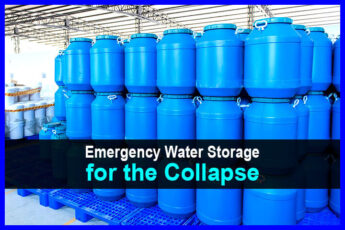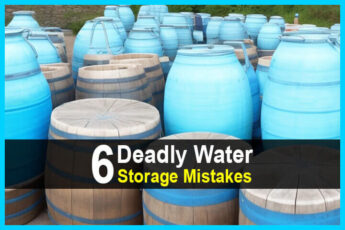Estimated reading time: 11 minutes
Greywater is water that has been recycled after a previous use. One of the classic examples is the reuse of laundry water to water a garden. There are other examples as well that reuses water from a bath tub or shower, or water from a sink in the kitchen or the bathroom. The idea is that any water that can be recovered from a previous task can potentially be saved and reused.
What’s makes greywater a viable water resource for reuse is that it is not intended for drinking or cooking. It’s use is usually limited to tasks like watering plants, washing vehicles or machinery, washing or rinsing floors in the garage, driveway, sidewalks and even decks and fences.
As a result, the water doesn’t require the usual purification steps you would use for any wild or recycled water intended for drinking or cooking. However, any greywater that is stored for any length of time should at least be filtered, and storing for reuse is what a greywater system is all about.
Want to save this post for later? Click Here to Pin It On Pinterest!
What is a Greywater System?

A greywater system is a combination of pipes and some improvised filters funneling previously used water from its source to a storage tank.
From the storage tank a spigot/faucet can be opened to dispense the water to a can or bucket, or a hose or pipe can be attached to direct the water to a destination like a garden bed.
A greywater system can be a simple project or more complex. It all depends on how much greywater you want to harvest. We’ll explore various types and greywater system designs later in this article.
Why Would Anyone Need Greywater?
A lot of the reasons that people are using greywater more and more has to do with the growing crisis surrounding water supplies. Droughts are becoming more common and a lament from many is the rising cost of water bills.
On a fundamental level, harvesting greywater can save some money. On a more critical level, harvesting greywater may be the only way to sufficiently water a garden or wash something as basic as car, tractor or fence when water is scarce.
In some parts of the country people have no choice as water restrictions are implemented limiting how much water anyone can use for any reason. If and when the day comes that water restrictions affect more and more people, greywater systems may become the new solution to another vanishing resource.
Three Approaches to Greywater Harvesting
It’s unrealistic to think that a whole lot of people are going to be overhauling the plumbing across their whole house so they can harvest every drop of water, but there are some simple ways to start the process with different approaches that are progressively more ambitious.
It starts with a basic greywater system that uses greywater from the washing machine. Most washing machines are located in laundry rooms with the washer and dryer backing up to an exterior wall. That exterior wall is key to any greywater system using a water resource inside a home.
If your washing machine is in the basement you may want to consider one of the other approaches we’ll cover. Greywater systems depend largely on gravity to harvest and reuse the greywater.
1. The Washing Machine as a Source of Greywater/Basic System
Our washing machines are always next to a dryer. All dryers have vents to the outside and they’re usually through a wall in the laundry room. If you look at where the vent is located in the laundry room and where it exits outside, you can easily locate a position to drill a 1-inch hole to allow the washing machine to drain outside.
Once you have a way to get the water outside rather than down the drain you’re on your way to having a regular greywater source.
What you need to do next is to drain the water into a filter container that then allows you to direct the water from the filter container to a water reservoir and finally to your garden. Here’s a sample diagram of how you could do that.
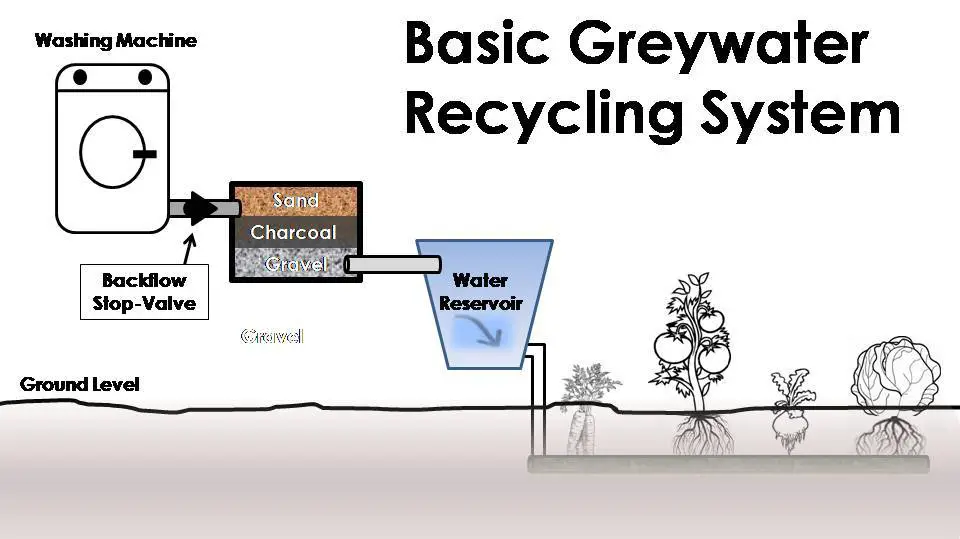
In this example the greywater is drained into a garden soaker hose. That’s the sole purpose of this setup –to water the garden every time you do the laundry.
The water reservoir is a trough or small barrel. It can be opened or closed. It’s essentially a holding tank to provide some pressure to the drain pipe leading into the garden soaker hose.
A critical addition to this setup is a backflow stop-valve. This prevents any water from backing up into the washing machine if the drainage slows down for any reason.
The combination of sand, charcoal and gravel helps get rid of fabric fibers that could clog the system and helps to neutralize some of the detergents used to do the laundry.
However, this filter will not neutralize bleach although bleach does eventually neutralize over time. However, high amounts of bleach could kill the beneficial bacteria in the soil. In fact, a lot of bleach can kill the plants.
If you use a lot of bleach in a load of sheets, use your greywater to wash the car or rinse the driveway instead of directing it to the garden all the time.
2. A Sink as a Basic Source of Greywater/Intermediate System
If your kitchen sink is located on an exterior wall you can improvise a similar drainage arrangement that you would do for a washing machine. However, if you have a garbage disposal do not direct any greywater from that drain.
Some would make the argument that it’s just adding compost to the water but compost is plant material. We don’t always know how much fat, oil, meat or seafood will find its way into a garbage disposal. Only collect water from that part of the sink that does not have a garbage disposal.
What’s good about a sink, particularly a kitchen sink, is that it gets a lot of use and there’s often a regular flow of water over the course the day. Here’s a basic setup using a kitchen sink as a source of greywater.
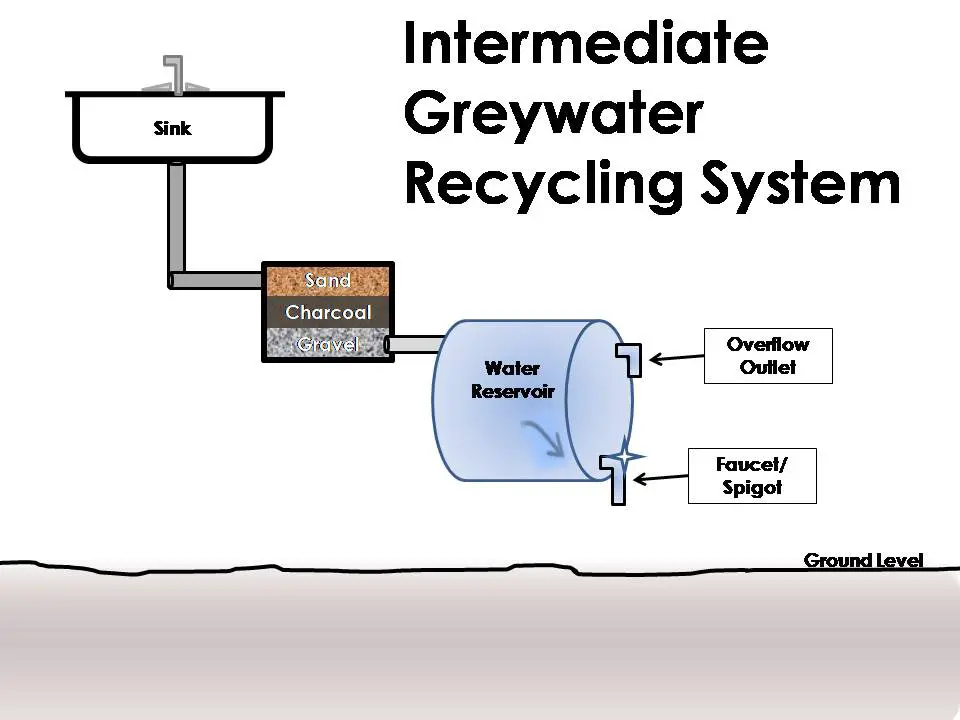
The filtration box is a layered combination of sand, charcoal and gravel. The sand and gravel removes particulate matter and the charcoal neutralizes any odors. You could also add a bio-filter if you want added filtration.
The drain is a faucet/spigot that can be used to fill buckets, watering cans or hooked up to a hose for washing or rinsing exterior surfaces like a deck or driveway. The hose can also be connected to a separate soaker hose for watering the garden.
The idea is flexibility. It’s not confined to watering a garden and the larger storage tank can provide greywater for a variety of uses. The tank also has an overflow valve in case the water backs up into the tank. This overflow valve could be hooked to a hose leading to the garden to water plants whenever there’s any overflow.
3. A Bathtub as a Source of Greywater/Advanced System
This is another way to harvest greywater and may be the cleanest source. Washing machines have chemicals ranging from bleach to fabric softeners and anything can find its way into a sink. A bathtub or shower tends to be a bit cleaner with soap, shampoo and conditioners as the only thing added. It stands to reason that if they’re safe to use on your body they’ll be pretty safe when reused.
However, body hair and flakes of skin often find their way into a bathtub drain so any bathwater should also be filtered. Another potential benefit is that some bathtubs are on the second floor of a home. For a system that largely depends on gravity to function, a second story will ensure a strong flow of greywater under pressure.
There’s also a good volume of water from baths and even showers. That means you could use a larger storage tank and have sufficient greywater for a variety of uses.
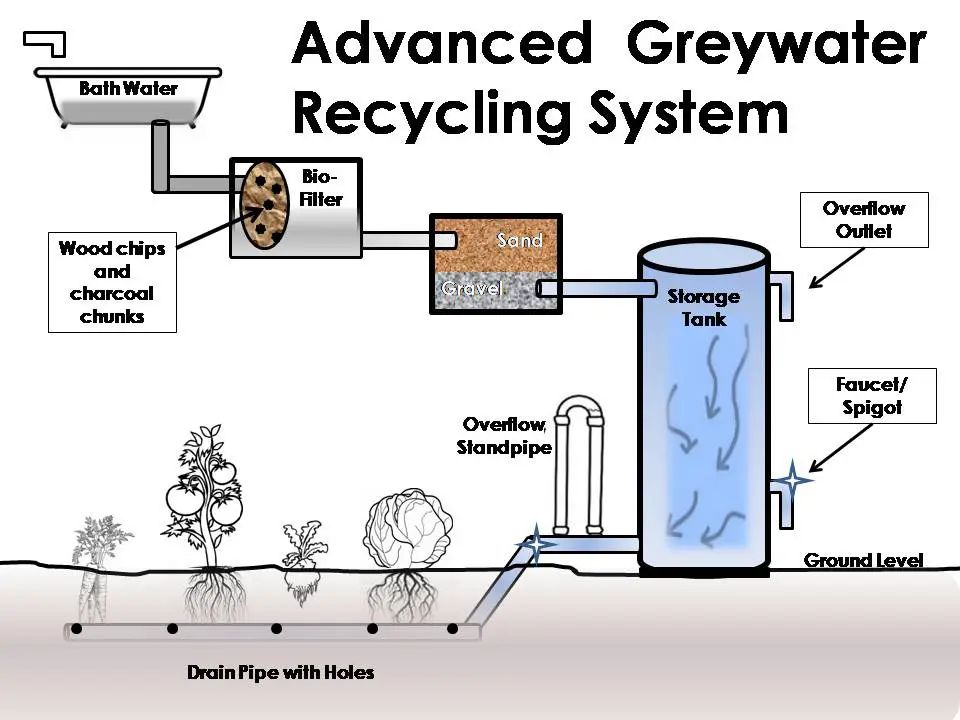
This is an advanced system for a few reasons. For one, it uses a large storage tank for the grey water. There are multiple ways to tap the water from an outlet that goes directly to the garden to a faucet/spigot for harvesting the water for any other use. It also has an overflow spout so any excess water can drain. Where it drains is up to you but most people direct it to plants somewhere in the yard or garden.
It also has something called a bio filter. It’s a mesh bag attached to the drain pipe from the bathtub that’s filled with wood chips and chunks of charcoal. This helps to neutralize the water and remove any odors before going to a filter layered with sand and gravel leading to the storage tank.
Because the storage tank is so large, other water sources can be connected including a rainwater collection system. Even during a drought there’s occasional rain and there’s no reason your greywater systems can’t do double duty.
If adding rainwater to your collection efforts, the roof of your home and the rain gutters are the best collection point. That’s up to you. Here’s a link to an article that tells you more about rainwater collection.
Supplies and Tools for a Greywater system
Exactly what you’ll need will vary depending on the ambition of your greywater collecting, but here are some basics you’ll need to track down if you want to explore greywater collection.
Tools
- Assorted pipe wrenches for working with existing plumbing
- Hacksaw for cutting PVC and any stubborn pipes
- Drill and assorted bits for drilling through wood, metal, plastic, PVC and anything else to channel and direct water through your system
- Carpentry tools for supports or any other structures you need to support components in the system
Supplies
- A basic water tank setup. The size depends on the ambition of your system. Smaller tanks if you only plan to use occasional greywater, and larger tanks if you have severe challenges to your water supply and need to maximize and reuse your water as much as possible.
- PVC pipe and fittings to create bends, turns and connections to run pipe across your system. The size of the pipe depends on the size of your system and the existing plumbing you’re connecting to.
- PVC primer and cement if using PVC pipes.
- Backflow, stop-valves to prevent any excess greywater from backing into your system and flooding your sink, tub or washing machine.
- Watertight boxes or drums that can be used to contain coarse filter materials like sand, gravel, and charcoal.
- Mesh bags for filtration attached directly to a pipe at a water collection point to contain wood chips or chunks of charcoal.
- Garden hoses for easy hook ups and greywater distribution.
- Soaker hoses for yard and garden to automatically drain greywater and reuse.
- Faucets and spigots that fit your greywater plumbing.
- Valves that allow you to close down a pipe or hose if you are using your greywater storage for more than one use. This lets you shut down the hose to the garden if you want to reserve more water for washing a car or washing down a sidewalk.
Greywater Fails
Like anything else, things can go wrong. Here are some things to avoid doing when reusing greywater.
- Failing to install backflow valves to prevent excess water from backing up into the plumbing in your home.
- Failing to install overflow pipes so that accumulated water in a tank doesn’t build pressure in the tank as more water is introduced into the system.
- Failing to use greywater on a regular basis. That’s why it’s wise to allow any greywater to be automatically directed to a garden unless you’re conserving it for a special project. Valves on any outlet allows you to restrict the flow. If greywater is unused and sits in the storage tank for any length of time bacteria can grow. Greywater is not pure and over time any residual bacteria will multiply creating off odors.
- Trying to purify greywater for drinking and forgetting that many and varied chemicals could have found their way into the greywater, especially from washing machines and sinks.
- Using greywater from a washing machine in a garden if bleach or other laundry chemicals like fabric softeners were added. The chemicals can kill the plants and beneficial bacteria in the soil.
Is This Really Necessary?
That all depends on your situation. In many parts of the world including the U.S. water is becoming a scarce commodity. As time goes on and climate change continues to take its toll, many of our natural resources will be slowly exhausted.
When the water restrictions start to show up and the monthly water bill starts to become the most expensive utility cost, it may be time to rethink how we use water and think seriously about a greywater system.


